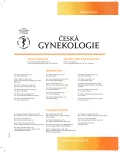Uterine adenomyosis: pathogenesis, diagnostics, symptomatology and treatment
Authors:
J. Lacheta
Authors place of work:
Centrum asistované reprodukce ISCARE I. V. F., Praha, primář MUDr. J. Lacheta
Published in the journal:
Ceska Gynekol 2019; 84(3): 240-246
Category:
Přehledový článek
Summary
Objective: To summarize the current knowledge about pathogenesis, diagnostics, symptomatology and the treatment of adenomysis.
Design: Review article.
Setting: The Centre of Assisted Reproduction, ISCARE I.V.F., Prague.
Methods: Analysis of literature and current studies.
Results: This article reviews etiology, diagnostics and classification of adenomyosis, medical and surgical management options and the fertility implication of adenomyosis.
Conclusion: Uterine adenomyosis is characterized by the presence of endometrial glands in myometrium and usually manifests by pelvic pain, abnormal uterine bleeding or infertility. Although adenomyosis and endometriosis share a number of features, they are considered to be two different entities. Recent improvements of imaging techniques such as transvaginal ultrasound and magnetic resonance imaging have affected the detection of adenomyosis. Adenomyosis has a negative impact on IVF results.
Keywords:
Pathogenesis – infertility – In vitro fertilization – adenomyosis
Zdroje
1. Benagiano, G., Habiba, M., Brosens, I. The pathophysiology of uterine adenomyosis: an update. Fertil Steril, 2012, 98, p. 572–579.
2. Bergeron, C., Amant, F., Ferenczy, A. Pathology and physiopathology of adenomyosis. Best Pract Res Clin Obstet Gynaecol, 2006, 20, p. 511–521.
3. Champaneria, R., Abedin, P., Daniels, J., et al. Ultrasound scan and magnetic resonance imaging for the diagnosis of adenomyosis: systematic review comparing test accuracy. Acta Obstet Gynecol Scand, 2010, 89, p. 1374–1384.
4. Chen, Y., Zhu, B., Zhang, H., et al. Epigallocatechin3-gallate reduces myometrial infiltration, uterine hyperactivity, and stresslevels and alleviates generalized hyperalgesia in mice induced with adenomyosis. Reprod Sci, 2013, 20, p. 1478–1491.
5. Devlieger, R., D‘Hooghe, T., Timmerman, D. Uterine adenomyosis in the infertility clinic. Hum Reprod Update, 2003, 9, p. 139–147.
6. Dueholm, M. Minimally invasive treatment of adenomyosis. Best Pract Res Clin Obstet Gynaecol, 2018, 51, p. 119–137.
7. Fawzy, M., Mesbah, Y. Comparison of dienogest versus triptorelin acetate in premenopausal women with adenomyosis: a prospective clinical trial. Arch Gynecol Obstet, 2015, 292, p. 1267–1271.
8. Gordts, S., Grimbizis, G., Campo, R. Symptoms and classification of uterine adenomyosis, including the place of hysteroscopy in diagnosis. Fertil Steril, 2018, 109, p. 380–388.
9. Grimbizis, GF., Mikos, T., Tarlatzis, B. Uterus-sparing operative treatment for adenomyosis. Fertil Steril, 2014, 101, p. 472–487.
10. Hufnagel, D., Li, F., Cosar, E., et al. The role of stem cells in the etiology and pathophysiology of endometriosis. Semin Reprod Med, 2015, 33, p. 333–340.
11. Juang, CM., Chou, P., Yen, MS., et al. Adenomyosis and risk of preterm delivery. BJOG, 2006, 114, p. 165–169.
12. Kamada, Y., Nakatsuka, M., Asagiri, K., et al. GnRH agonist-suppressed expression of nitric oxide synthases and generation of peroxynitrite in adenomyosis. Hum Reprod, 2000, 15, p. 2512–2519.
13. Kissler, S., Siebzehnruebl, E., Kohl, J., et al. Uterine contractility and directed sperm transport assessed by hysterosalpingoscintigraphy (HSSG) and intrauterine pressure (IUP) measurement. Acta Obstet Gynecol Scand, 2004, 83, p. 369–374.
14. Leyendecker, G., Bilgicyildirim, A., Inacker, M., et al. Adenomyosis and endometriosis. Re-visiting their association and further insights into the mechanisms of auto-traumatisation. An MRI Study. Arch Gynecol Obstet, 2015, 291, p. 917–932.
15. Maubon, A., Faury, A., Kapella, M., et al. Uterine junctional zone at magnetic resonance imaging: a predictor of in vitro fertilization implantation failure. J Obstet Gynaecol Res, 2010, 36, p. 611–618.
16. McCausland, AM. Hysteroscopic myometrial biopsy: its use in diagnosing adenomyosis and its clinical application. Am J Obstet Gynecol, 1992, 166, p. 1619–1628.
17. Mochimaru, A., Aoki, S., Oba, MS., et al. Adverse pregnancy outcomes associated with adenomyosis with uterine enlargement. J Obstet Gynaecol Res, 2015, 41, p. 529–533.
18. Niu, Z., Chen, Q., Sun, Y., et al. Long-term pituitary downregulation before frozen embryo transfer could improve pregnancy outcomes in women with adenomyosis. Gynecol Endocrinol, 2013, 29, p. 1026–1030.
19. Okada, H., Okamoto, R., Tsuzuki, T., et al. Progestins inhibit estradiol-induced vascular endothelial growth factor and stromal cell-derived factor 1 in human endometrial stromal cells. Fertil Steril, 2011, 96, p. 786–791.
20. Park, CW., Choi, MH., Yang, KM., et al. Pregnancy rate in women with adenomyosis undergoing fresh or frozen embryo transfer cycles following gonadotropin-releasing hormone agonist treatment. Clin Exp Reprod Med, 2016, 43, p. 169–173.
21. Peric, H., Fraser, IS. The symptomatology of adenomyosis. Best Pract Res Clin Obstet Gynaecol, 2006, 20, p. 547–555.
22. Taran, FA., Wallwiener, M., Kabashi, D., et al. Clinical characteristics indicating adenomyosis at the time of hysterectomy: a retrospective study in 291 patients. Arch Gynecol Obstet, 2012, 285, p. 1571–1576.
23. Vannuccini, S., Luisi, S., Tosti, C., et al. Role of medical therapy in the management of uterine adenomyosis. Fertil Steril, 2018, 109, p. 398–405.
24. Vannuccini, S., Tosti, C., Carmona, F., et al. Pathogenesis of adenomyosis: an update on molecular mechanisms. Reproductive BioMedicine Online, 2017, 35, p. 592–601.
25. Vercellini, P., Consonni, D., Dridi, D., et al. Uterine adenomyosis and in vitro fertilization outcome: a systematic review and meta-analysis. Hum Reprod, 2014, 29, p. 964–977.
26. Wildt, L., Kissler, S., Licht, P., et al. Sperm transport in the human female genital tract and its modulation by oxytocin as assessed by hysterosalpingoscintigraphy, hysterotonography, electrohysterography and Doppler sonography. Hum Reprod Update, 1998, 4, p. 655–666.
27. Younes, G., Tulandi, T. Effects of adenomyosis on in vitro fertilization treatment outcomes: a meta-analysis. Fertil Steril, 2017, 108, p. 483–490.
Štítky
Dětská gynekologie Gynekologie a porodnictví Reprodukční medicínaČlánek vyšel v časopise
Česká gynekologie

2019 Číslo 3
- Primární prevence osteoporózy v kostce
- Horní limit denní dávky vitaminu D: Jaké množství je ještě bezpečné?
- Isoprinosin je bezpečný a účinný v léčbě pacientů s akutní respirační virovou infekcí
- Dlouhodobé užívání dienogestu v terapii endometriózy
- Ferinject: správně indikovat, správně podat, správně vykázat
Nejčtenější v tomto čísle
- Děložní adenomyóza: patogeneze, diagnostika, symptomatologie a léčba
- Echogenní fokusy fetálního srdce z pohledu dětského kardiologa
- Vaginismus – koho zajímá?
- Lokálně pokročilý kolorektální karcinom v těhotenství
